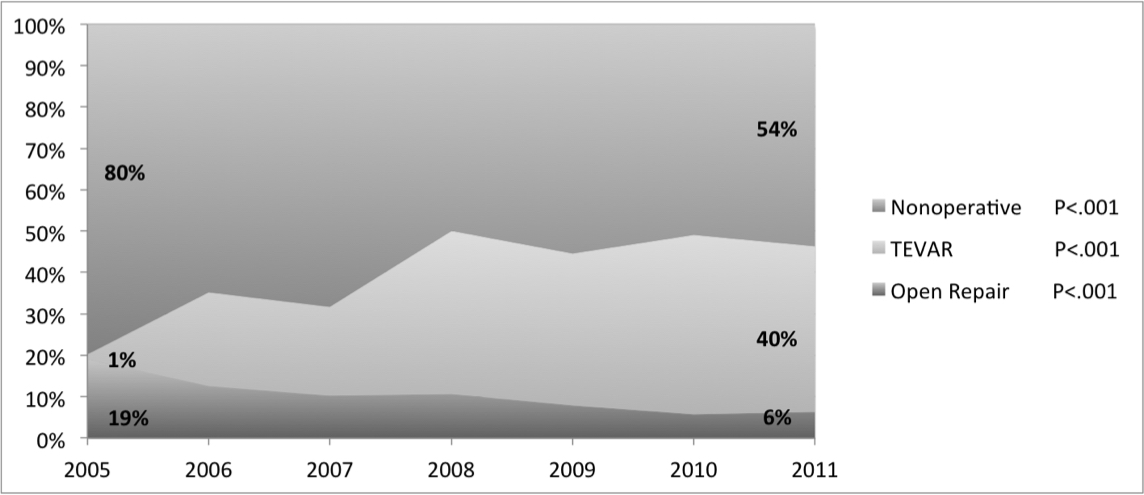|
Back to 2016 Annual Symposium Abstacts
National Trends in Utilization and Outcome of Thoracic Endovascular Aortic Repair for Traumatic Thoracic Aortic Injuries
Klaas H. Ultee1, Peter A. Soden, MD1, Victor Chien, MD1, Rodney P. Bensley, MD1, Sara L. Zettervall, MD, MPH1, Hence JM Verhagen, MD, PhD2, Marc L. Schermerhorn, MD1.
1Beth Israel Deaconess Medical Center, Boston, MA, USA, 2Erasmus Medical Center, Rotterdam, Netherlands.
OBJECTIVES:
Endovascular repair of traumatic thoracic aortic injuries (TTAI) is an alternative to conventional open surgical repair. Single institution studies have shown a survival benefit with TEVAR, but it is not clear if this is being realized nationally. The purpose of our study was to document trends in the increase in utilization of TEVAR and its impact on outcomes of TTAI nationally.
METHODS:
Patients admitted with a traumatic thoracic aortic injury between 2005 and 2011 were identified in the National Inpatient Sample (NIS). Patients were grouped by treatment into TEVAR, open repair, or nonoperative management groups. Primary outcomes were relative utilization over time and in-hospital mortality. Multivariable logistic regression was performed to identify independent predictors of mortality.
RESULTS:
A total of 8384 patients were included, with 2492 (29.7%) undergoing TEVAR, 848 (10.1%) open repair, and 5044 (60.2%) managed nonoperatively. TEVAR has become the dominant treatment option for TTAI over the study period, starting at 6.5% of interventions in 2005 and accounting for 86.5% of interventions in 2011 (P<.001). Nonoperative management declined concurrently with the widespread of adoption TEVAR (79.8% to 53.7%, P<.001). In-hospital mortality following TEVAR decreased over the study period (33.3% in 2005 to 4.9% in 2011, P<.001), while an increase in mortality was observed for open repair (13.9% to 19.2%, P<.001). Procedural mortality (either TEVAR or open repair) decreased from 14.9% to 6.7% (P<.001), and mortality following any TTAI admission declined from 24.5% to 13.3% over the study period (P<.001). In adjusted mortality analyses, open repair was associated with twice the mortality risk compared to TEVAR (OR: 2.0, 95% CI: 1.6 - 2.6), while nonoperative management was associated with more than a four-fold increase in mortality (OR: 4.2, 95% CI: 3.6 - 5.0).
CONCLUSIONS:
TEVAR is now the dominant surgical approach in TTAI with substantial perioperative morbidity and mortality benefits over open aortic repair. Overall mortality following admission for TTAI has declined, which is most likely the result of both the replacement of open repair by TEVAR, as well as the broadened eligibility for operative repair.

Back to 2016 Annual Symposium Abstacts
|







